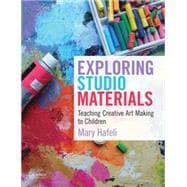Exploring Studio Materials: Teaching Creative Art Making to Children is a transformative approach to teaching art in elementary and secondary schools. Based on the model of how real artists create their work, the text encourages teachers to work with the most common media and materials found in the Pre-K-12 curriculum. Hafeli provides a rich blend of real-life examples and suggested classroom activities in order to help fledgling art teachers learn how to implement creative arts programs that will produce exceptional results.
Rather than following a structure based on preconceived ideas, the book encourages experimental techniques with the materials that teachers commonly use in elementary and secondary classrooms. Therefore, teaching methodologies emerge from the activities themselves, rather than vice versa. Based on her own research, teaching, and contemporary approaches to arts education, this approach is an effective model for bringing artistic creativity into the school curriculum.
Distinctive Features
* Encourages teachers to work with the most common media and materials found in the Pre-K-12 curriculum
* Establishes a meaningful, organic, and creative process in which teachers are discovering along with students
* Includes a rich combination of real-life examples and suggested classroom activities








